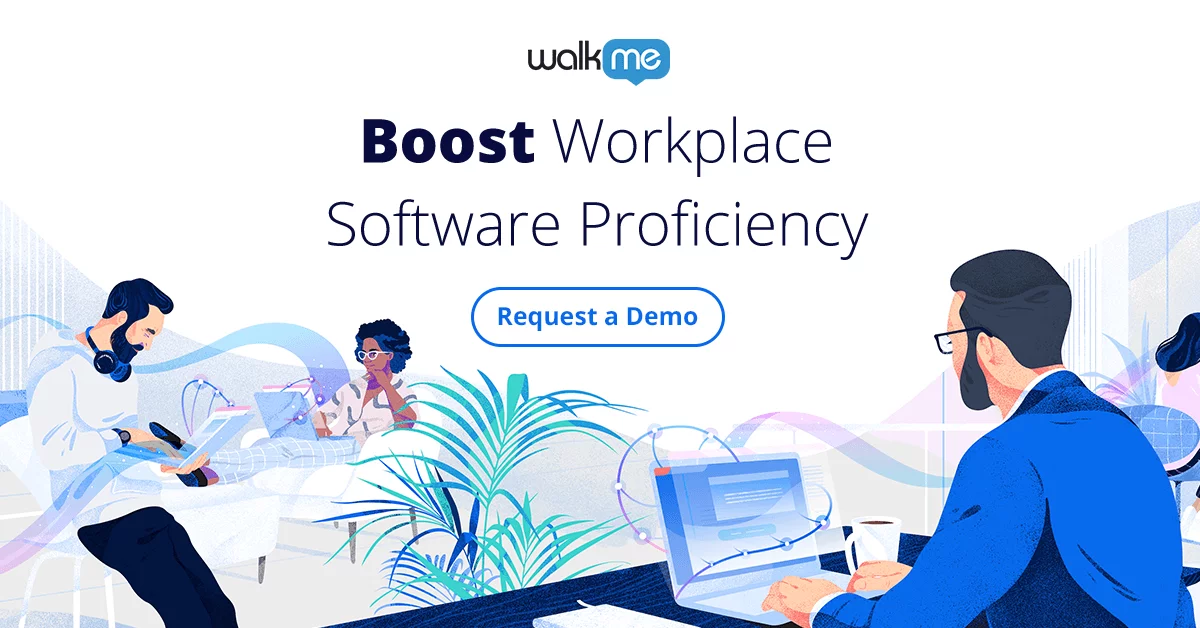We all understand the critical role software plays in your employees’ ability to innovate, increase productivity, and fulfill business goals.
However, the software rollout and integration processes continue to trip up many organizations, with the majority ending up in failure.
This challenge is compounded by the need to routinely add new software to employees’ workflow. For project teams and department leaders working on a software rollout plan, there are a few main questions to consider.
 From the planning stage throughout the implementation process, maintaining strong lines of communication with key stakeholders will be critical to assuring a successful software rollout.
In the initial stage, start by gathering all relevant stakeholders to ask for their needs and goals related to the new software, as well as questions and potential challenges. By addressing all of these points right away, you can achieve alignment from the start and make the rest of the process much easier.
One way of achieving this is by performing an I.M.P.A.C.T. analysis. This stands for Investment, Market, People and Culture, Activity (process), Customer, and Technology. Each stakeholder should perform the analysis for their area of the business, identifying areas of risk for the rollout.
This information will then help guide how you approach the rollout and contribute to the plan going forward.
One thing is for sure, if every stakeholder feels they have contributed to the implementation plan, they will be more engaged throughout the rollout and help ensure its success.
From the planning stage throughout the implementation process, maintaining strong lines of communication with key stakeholders will be critical to assuring a successful software rollout.
In the initial stage, start by gathering all relevant stakeholders to ask for their needs and goals related to the new software, as well as questions and potential challenges. By addressing all of these points right away, you can achieve alignment from the start and make the rest of the process much easier.
One way of achieving this is by performing an I.M.P.A.C.T. analysis. This stands for Investment, Market, People and Culture, Activity (process), Customer, and Technology. Each stakeholder should perform the analysis for their area of the business, identifying areas of risk for the rollout.
This information will then help guide how you approach the rollout and contribute to the plan going forward.
One thing is for sure, if every stakeholder feels they have contributed to the implementation plan, they will be more engaged throughout the rollout and help ensure its success.
 Your new software’s value as only as high as your employees’ ability to use it. In other words, you can have the most sophisticated, best-in-class tool, but if no one can use it properly, you might as well have not purchased it at all.
Making software onboarding and ongoing training a top priority is a critical part of achieving the full potential value of your digital assets. Additionally, training helps foster engagement and a more positive user experience for employees.
However, it’s important to note that not all training methods are created equally. Traditional methods of training, such as one-on-one instruction, lengthy webinars, or dense training manuals are not good for ensuring knowledge retention. Moreover, they take your employees away from their work, contributing to lost productivity.
The key effective training while keeping productivity high is contextual learning.
Digital learning solutions that enable contextual learning, like WalkThrus, allow employees to “learn in the flow of work.” They’re highly personalized, make information easily accessible, and promote self-service.
Your new software’s value as only as high as your employees’ ability to use it. In other words, you can have the most sophisticated, best-in-class tool, but if no one can use it properly, you might as well have not purchased it at all.
Making software onboarding and ongoing training a top priority is a critical part of achieving the full potential value of your digital assets. Additionally, training helps foster engagement and a more positive user experience for employees.
However, it’s important to note that not all training methods are created equally. Traditional methods of training, such as one-on-one instruction, lengthy webinars, or dense training manuals are not good for ensuring knowledge retention. Moreover, they take your employees away from their work, contributing to lost productivity.
The key effective training while keeping productivity high is contextual learning.
Digital learning solutions that enable contextual learning, like WalkThrus, allow employees to “learn in the flow of work.” They’re highly personalized, make information easily accessible, and promote self-service.

 We’re talking about a lot of communication here. Unless you’re organized on how you collect and manage these correspondences, valuable information could get lost along the way.
One way to avoid this is by nominating a point-person to represent different stakeholders. For example, say you’re implementing Workday®. Each department may want a point-person to represent their teams’ needs and goals. Within your HR department, you might have a point-person from recruiting, one from compensation, one from employee benefits, etc., to represent those objectives. IT will have a main contact, and so will legal.
By making it clear who can answer specific questions, or who to escalate issues to, you can eliminate a lot of wasted time and frustration.
We’re talking about a lot of communication here. Unless you’re organized on how you collect and manage these correspondences, valuable information could get lost along the way.
One way to avoid this is by nominating a point-person to represent different stakeholders. For example, say you’re implementing Workday®. Each department may want a point-person to represent their teams’ needs and goals. Within your HR department, you might have a point-person from recruiting, one from compensation, one from employee benefits, etc., to represent those objectives. IT will have a main contact, and so will legal.
By making it clear who can answer specific questions, or who to escalate issues to, you can eliminate a lot of wasted time and frustration.
- How do you ensure your implementation will meet users’ needs and fulfill business goals?
- How do you mitigate resistance and provide a consistently positive digital employee experience?
- How do you minimize the inevitable “productivity paradox” that comes with introducing an unfamiliar software?
1. Involve stakeholders
 From the planning stage throughout the implementation process, maintaining strong lines of communication with key stakeholders will be critical to assuring a successful software rollout.
In the initial stage, start by gathering all relevant stakeholders to ask for their needs and goals related to the new software, as well as questions and potential challenges. By addressing all of these points right away, you can achieve alignment from the start and make the rest of the process much easier.
One way of achieving this is by performing an I.M.P.A.C.T. analysis. This stands for Investment, Market, People and Culture, Activity (process), Customer, and Technology. Each stakeholder should perform the analysis for their area of the business, identifying areas of risk for the rollout.
This information will then help guide how you approach the rollout and contribute to the plan going forward.
One thing is for sure, if every stakeholder feels they have contributed to the implementation plan, they will be more engaged throughout the rollout and help ensure its success.
From the planning stage throughout the implementation process, maintaining strong lines of communication with key stakeholders will be critical to assuring a successful software rollout.
In the initial stage, start by gathering all relevant stakeholders to ask for their needs and goals related to the new software, as well as questions and potential challenges. By addressing all of these points right away, you can achieve alignment from the start and make the rest of the process much easier.
One way of achieving this is by performing an I.M.P.A.C.T. analysis. This stands for Investment, Market, People and Culture, Activity (process), Customer, and Technology. Each stakeholder should perform the analysis for their area of the business, identifying areas of risk for the rollout.
This information will then help guide how you approach the rollout and contribute to the plan going forward.
One thing is for sure, if every stakeholder feels they have contributed to the implementation plan, they will be more engaged throughout the rollout and help ensure its success.
2. Identify potential challenges
One product of an I.M.P.A.C.T. analysis is to identify the challenges that could arise in the wake of a software rollout. Identifying these ahead of time will help mitigate their effects and safeguard productivity. Listen to the concerns of your teams. They may hold vital information on what has failed in the past and suggestions for how you can avoid making the same mistakes again. Having open lines of communication are essential to making sure employees feel comfortable coming forward to voice their concerns. Once you identify potential roadblocks, create a strategy to preempt them. By putting in place a certain set of guidelines and best practices, you can achieve standardization while preventing controllable hurdles. Of course, there will be some unexpected bumps in the road. For those issues, you should have a strategy that enables quick problem resolution, preferably through self-service, so you can reduce the burden on your IT department. Digital solutions that offer real-time, onscreen guidance and support are a proven way to ensure maximum efficiency — both for completing regular work and solving issues.3. Make training a top priority
 Your new software’s value as only as high as your employees’ ability to use it. In other words, you can have the most sophisticated, best-in-class tool, but if no one can use it properly, you might as well have not purchased it at all.
Making software onboarding and ongoing training a top priority is a critical part of achieving the full potential value of your digital assets. Additionally, training helps foster engagement and a more positive user experience for employees.
However, it’s important to note that not all training methods are created equally. Traditional methods of training, such as one-on-one instruction, lengthy webinars, or dense training manuals are not good for ensuring knowledge retention. Moreover, they take your employees away from their work, contributing to lost productivity.
The key effective training while keeping productivity high is contextual learning.
Digital learning solutions that enable contextual learning, like WalkThrus, allow employees to “learn in the flow of work.” They’re highly personalized, make information easily accessible, and promote self-service.
Your new software’s value as only as high as your employees’ ability to use it. In other words, you can have the most sophisticated, best-in-class tool, but if no one can use it properly, you might as well have not purchased it at all.
Making software onboarding and ongoing training a top priority is a critical part of achieving the full potential value of your digital assets. Additionally, training helps foster engagement and a more positive user experience for employees.
However, it’s important to note that not all training methods are created equally. Traditional methods of training, such as one-on-one instruction, lengthy webinars, or dense training manuals are not good for ensuring knowledge retention. Moreover, they take your employees away from their work, contributing to lost productivity.
The key effective training while keeping productivity high is contextual learning.
Digital learning solutions that enable contextual learning, like WalkThrus, allow employees to “learn in the flow of work.” They’re highly personalized, make information easily accessible, and promote self-service.

4. Provide honest and constructive feedback
Listening to and incorporating user feedback is an essential part of ensuring a successful rollout. If you choose to ignore your employees’ input, you run the risk of inciting employee frustration, disengagement, and your exciting new software becoming “shelf-ware.” Alternatively, opening channels of communication with your employees and creating an active feedback loop will give you the information required to improve the software rollout. Perhaps your approach to software training is inadequate. Maybe your IT department is struggling to keep up with the growing volume of support tickets. It could be that your team leaders don’t have enough knowledge about the new platform to support their employees. By soliciting feedback on a regular basis, you can take steps to course correct and make everyone’s experience better.5. Nominate a point-person to streamline communication
 We’re talking about a lot of communication here. Unless you’re organized on how you collect and manage these correspondences, valuable information could get lost along the way.
One way to avoid this is by nominating a point-person to represent different stakeholders. For example, say you’re implementing Workday®. Each department may want a point-person to represent their teams’ needs and goals. Within your HR department, you might have a point-person from recruiting, one from compensation, one from employee benefits, etc., to represent those objectives. IT will have a main contact, and so will legal.
By making it clear who can answer specific questions, or who to escalate issues to, you can eliminate a lot of wasted time and frustration.
We’re talking about a lot of communication here. Unless you’re organized on how you collect and manage these correspondences, valuable information could get lost along the way.
One way to avoid this is by nominating a point-person to represent different stakeholders. For example, say you’re implementing Workday®. Each department may want a point-person to represent their teams’ needs and goals. Within your HR department, you might have a point-person from recruiting, one from compensation, one from employee benefits, etc., to represent those objectives. IT will have a main contact, and so will legal.
By making it clear who can answer specific questions, or who to escalate issues to, you can eliminate a lot of wasted time and frustration.

